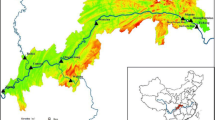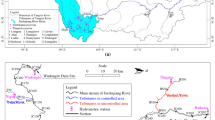Abstract
Jing River is a tributary of the Wei River which is the largest tributary of the Yellow River. Sediments eroded from the upland of the Jing River basin are one of the major contributors of sediment entering the lower Wei River (LWR). The Dongzhuang reservoir is designed to be constructed on the lower Jing River for flood control and water resources regulation, and this may change the sustainable management of the LWR as changed channel deposition by trapping sediments and releasing concentration-limited flow. Its effects on the LWR, especially the deposition distribution, should be analyzed. The steady quasi-two-dimensional dynamic model was adopted to estimate the deposition processes in the LWR. Then, the qualitative effects of the Dongzhuang reservoir on channel deposition were evaluated and compared with historical data, including capacity loss in other reservoirs and measured deposition in the LWR. Analyses indicated that the annual deposition in the LWR will decrease by approximately two-thirds due to the reservoir’s operation. After 15 years of operation, the effects of the Dongzhuang reservoir on the lower channel will decrease gradually. Moreover, its effects on lateral distribution in different sub-reaches are different. After the reservoir’s operation, the floodplain of the Xianyang-Lintong (XY-LT) sub-reach will change its sediment regime from deposition to erosion. For the Lintong-Huaxian (LT-HX) sub-reach, deposition in the main channel will be more serious during the first 30 years of operation. For the Huaxian-Tongguan (HX-TG) sub-reach, the reservoir will have almost no effects on the lateral distribution. All these analyses may benefit the sustainable management of the Wei River and the Yellow River.
Similar content being viewed by others
References
Ashouri M, Piry Z, Moghaddam MHR (2015) A comparison of the influence of the Sattarkhan reservoir dam on the upstream and downstream of the Ahar Chai River, NW Iran. Environ Earth SCI 73: 4099–4108. https://doi.org/10.1007/s12665-014-3695-6
Basson G (2010) Sedimentation and sustainable use of reservoirs and river systems. International Commission on Large Dams (ICOLD) Bulletin. Available from: http://www.icold-cigb.org/userfiles/files/CIRCULAR/CL1793Annex.pdf
Chang JX, Li YY, Wei J, et al. (2016) Dynamic changes of sediment load and water discharge in the Weihe River, China. Environ Earth Sci 75: 1042. https://doi.org/10.1007/s12665-016-5841-9
He L, Duan JG, Wang GQ, Fu XD (2012a) Case study: Numerical simulation of unsteady hyper-concentrated sediment-laden flow in the Yellow River. J Hydraul Eng 138(11): 958–969. https://doi.org/10.1061/(ASCE)HY.1943-7900.0000599
He L, Wang GQ, Zhang C (2012b) Application of loosely coupled watershed model and channel model in Yellow River, China. J Environ Inform 19(1): 30–37. https://doi.org/10.3808/jei.201200206
He L (2008) Analysis of Variation of water and sediment yield in different source areas and its effect on fluvial response in Lower Yellow River. PhD thesis, Tsinghua University, Beijing. (In Chinese)
He L (2018). Application of numerical model in evaluating the effects of a planned reservoir on reach-scale bankfull discharge of the lower Wei River. J Mt Sci 15(5): 1057–1070. https://doi.org/10.1007/s11629-017-4657-8
He Y, Wang F, Mu XM, et al. (2015) As assessment of human versus climate impacts on Jing River basin, Loess Plateau, China. Adv Meteorol 478739. https://doi.org/10.1155/2015/478739
Jiang JJ (2004). Influence of water and sediment adjustment by Dongzhuang reservoir on the scour and sediment in the lower reach of the Weihe River and water level at Tongguan station. J Sediment Res (5): 51–55. (In Chinese) 0468-155X(2004)0:5<51:DZSKDS>2.0.TX;2-#
Kong D, Miao C, Wu J, et al. (2017). Environmental impact assessments of the Xiaolangdi Reservoir on the most hyperconcentrated laden river, Yellow River, China. Environ Sci Pol R 24(5): 4337. https://doi.org/10.1007/s11356-016-7975-4
Lewis SE, Bainbridge ZT, Kuhnert PM, et al. (2013) Calculating sediment trapping efficiencies for reservoirs in tropical settings: a case study from the Burdekin falls dam, NE Australia. Water Resour Res 49: 1017–1029. https://doi.org/10.1002/wrcr.20117
Liang YJ, Xie W, Zhao ZW, et al. (2016). Research on Lower Weihe River sediment reduction of Dongzhuang Reservoir operational models. Yellow River 38(10): 131–136. (In Chinese) https://doi.org/10.3969/j.iss.1000-1379.2016.10.027
Mahmood K (1987) Reservoir sedimentation: impact, extent, and mitigation. Washington, DC: International Bank for Reconstruction and Development. (Technical paper. Report no. WTP71).
Nilsson C, Reidy CA, Dynesius M, et al. (2005). Fragmentation and flow regulation of the world’s large river systems. Science 308(5720): 405–408. https://doi.org/10.1126/science.1107887
Palmieri A, Shah F, Annandale G, et al. (2014) Reservoir conservation. In: Dictionary Geotechnical Engineering/Wörterbuch GeoTechnik. Springer, Berlin, Heidelberg. https://doi.org/10.1007/978-3-642-41714-6_181687
Plangeon P, Babel MS, Clemente RS, et al. (2013) Simulating the impact of future land use and climate change on soil erosion and deposition in the Mae Nam Nan sub-catchment, Thailand. Sustain-BASEL 5: 3244–3274. https://doi.org/10.3390/su5083244
Poff NL, Hart DD (2002). How dams vary and why it matters for the emerging science of dam removal. BioScience 52(8): 659–668. 10.1641/0006-3568(2002)052[0659:HDVAWI]2.0.CO;2
Ren ME (2015). Sediment discharge of the Yellow River, China: past, present and future- A synthesis. Acta Oceanol Sin 34(2): 1–8. https://doi.org/10.1007/s13131-015-0619-6
Ran LS, Lu XX, Xin ZB, et al. (2013) Cumulative sediment trapping by reservoirs in large river basins: A case study of the Yellow River basin. Global Planet Change 100: 308–319. https://doi.org/10.1016/j.gloplacha.2012.11.001
Rustomji P, Zhang XP, Hairsine PB, et al. (2008) River sediment load and concentration responses to changes in hydrology and catchment management in the Loess Plateau region of China. Water Resour Res 44: W00A04. https://doi.org/10.1029/2007WR006656.
Shao WW, Shi CX, Fan XL, et al. (2013). Processes and mechanisms of sedimentation in channel and floodplain in the Lower Weihe River in 1960–1990. Sci Geogr Sin 33(10): 1268–1276. (In Chinese) 1000-0690(2013)33:10<1268:11NJWH>2.0.TX;2-6
Wang G, Wu B, Wang ZY (2005). Sedimentation problems and management strategies of Sanmenxia Reservoir, Yellow River, China. Water Resour Res 41(9): W09417. https://doi.org/10.1029/2004WR003919
Wang XY, Wang GF (2001). The effect of characteristic of flow and sediment of Dongzhuang reservoir to the lower Weihe River. Northwest Water Resour Water Eng 12(1): 53–55. (In Chinese) 1008-5858(2001)01-0053-03
Wang ZY, Zhao H, Shi Q, et al. (2011) Sedimentation management assessment of Sanmenxia Reservoir based on RESCON model. Yellow River 33: 25–28. (In Chinese) https://doi.org/10.3969/j.issn.1000-1379. 2011.09.011.
WCD (1997) Dams and Development: A New Framework for Decision-Making. Earthscan Publications Ltd, London. (356 pp.).
Wu BS, Wang GQ, Wang ZY, et al. (2004). Effect of changes in flow runoff on the elevation of Tongguan in Sanmenxia Reservoir. Chinese Science Bulletin-Chinese 49(15): 1658–1664. https://doi.org/10.1360/04we0046
Yang S, Milliman J, Li P, et al. (2011) 50,000 dams later: erosion of the Yangtze River and its delta. Glob Planet Change 75: 14–20. https://doi.org/10.1016/j.gloplacha.2010.09.006
Yu GX, Fu JC, Liu WB, et al. (2007). Dongzhuang reservoir and Tongguan stage. Hydropower Eng 23(7): 23–56. (In Chinese) 1674-0009(2007)06-0053-04
Zhang L (2013). Effects of Dongzhuang Reservoir on the lower Weihe Channel. Water Conservancy Sci Technol Econ 19(8): 37–39. (In Chinese) 1006-7175(2013)08-0037-03
Zhang SL, Wang YH, Yu PT, et al. (2010). Study for separating the impact of precipitation variation and human activities on runoff change of the upper reaches of Jing River. J Soil Water Conser 24(4): 53–58. (In Chinese) 1009-2242(2010)24:4<53:DLQFRL>2.0.TX;2-H
Zhang JJ, Zhang XP, Li R, et al. (2017) Did streamflow or suspended sediment concentration changes reduce sediment load in the middle reaches of the Yellow River? J Hydrol 546: 357–369. https://doi.org/10.1016/j.jhydrol.2017.01.002
Zheng S, Wu BS (2013) Simulation of sedimentation processes of the Xiaobeiganliu reach of the Yellow River and the lower Wei River. Proceedings of the 35th IAHR World Congress Vols I and II. pp 4361–4371.
Acknowledgements
The research reported in this manuscript is funded by the National Natural Science Foundation of China (Grants No. 51979264 and 51479179).
Author information
Authors and Affiliations
Corresponding author
Rights and permissions
About this article
Cite this article
He, L. Numerical evaluation of the effects of the Dongzhuang reservoir on channel deposition in the Lower Wei River in China. J. Mt. Sci. 18, 1550–1563 (2021). https://doi.org/10.1007/s11629-019-5899-4
Received:
Revised:
Accepted:
Published:
Issue Date:
DOI: https://doi.org/10.1007/s11629-019-5899-4




